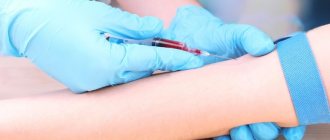Why is analysis needed and what does it give?
| During an annual medical examination, persons over 40 years of age are recommended to undergo a fecal occult blood test. The analysis reveals gastrointestinal pathologies in the early stages, which makes it possible to use it as a screening method. Any inflammation, polyp or tumor of the intestine is accompanied by bleeding, but the amount of blood is so small that it cannot be determined visually. However, this amount is sufficient to determine blood contamination using a laboratory method. |
There are two methods for determining occult blood in stool:
- benzidine (guaiac test)
- shows an admixture of any hemoglobin in the stool. Therefore, the method gives a number of errors in the absence of preparation in the form of a special diet three days before the test;
- immunochemical method
is the most accurate. It shows the presence of human hemoglobin, and not what comes from food. The method does not require special preparation. The disadvantage of the immunochemical method is the long readiness period, about 14 days.
Fecal occult blood test is a stool test performed to detect hidden bleeding from various parts of the gastrointestinal tract. It allows you to detect altered hemoglobin in erythrocytes even when the erythrocytes themselves are not detected during microscopic examination of stool.
Synonyms Russian
Examination of feces for occult blood.
English synonyms
Occult blood test, fecal occult blood test.
Research method
Gregersen's test (benzidine test).
What biomaterial can be used for research?
Cal.
How to properly prepare for research?
- Eliminate meat, fish, green vegetables, and tomatoes from the diet for 72 hours before the test.
- Avoid taking laxatives, administering rectal suppositories, oils, limit taking medications that affect intestinal motility (belladonna, pilocarpine, etc.) and the color of stool (iron, bismuth, barium sulfate) for 72 hours before stool collection.
- The study should be carried out before performing sigmoidoscopy and other diagnostic procedures in the intestines and stomach.
General information about the study
Analysis of feces for occult blood is an extremely important laboratory test in the diagnosis of hidden bleeding from various parts of the gastrointestinal tract. Such bleeding is one of the early symptoms of a number of serious gastrointestinal diseases, including cancer. With hidden bleeding, even long-term, it is very difficult to determine the presence of blood in the stool, both visually and microscopically, and most often simply impossible.
With heavy bleeding from various parts of the gastrointestinal tract, blood changes the appearance of stool so much that its presence can often be determined visually. If the bleeding is from the lower intestines (colon, rectum), the blood will be scarlet in color, possibly in the form of clots or impurities. If the source of bleeding is in the upper parts of the gastrointestinal tract (part of the small intestine, esophagus, stomach), then the stool turns black, “tarry” due to the interaction of blood and special enzymes produced in these parts of the gastrointestinal tract. As a rule, if there are visual signs of gastrointestinal bleeding, then the situation is acute and requires emergency measures (emergency care). However, with less pronounced violations of the integrity of the gastrointestinal mucosa, with the involvement of a small number of vessels in the process, the color and consistency of the stool do not change, but red blood cells in the stool will be visible during microscopic examination. If red blood cells are not visible microscopically, but there is a suspicion of hidden bleeding, then a stool test for occult blood is required. This study is carried out by measuring the amount of changed hemoglobin (and not the red blood cells themselves).
A positive stool reaction to occult blood means that a person has diseases of the gastrointestinal tract that cause disruption of the integrity of the mucous membrane when a small amount of blood is released into the lumen of the stomach or intestines. This can occur with stomach or duodenal ulcers, ulcerative colitis, Crohn's disease, polyps, and helminth infestations. Since tumors, primary and metastatic, cause damage to the gastrointestinal mucosa even if they are small in size, the study is used at the first stage of identifying gastrointestinal tumors. The determination of occult blood is especially important when diagnosing colon cancer, since it is with tumors in this part of the intestine that occult bleeding begins in the earliest stages.
Blood in the stool can also be detected during nosebleeds, bleeding from the gums and pharynx, in patients with varicose veins of the esophagus, erosive esophagitis, hemorrhoids and other diseases, so this must be taken into account when assessing the results of the analysis.
The reliability of the analysis is highest when it is repeated. Negative test results do not exclude the possible presence of an erosive-ulcerative or tumor lesion of the gastrointestinal tract in the patient. It is important that the results should be assessed in conjunction with other instrumental and laboratory studies, since they themselves cannot be the only criterion for making a diagnosis.
Sometimes all stool tests for occult blood are mistakenly called the Gregersen test or Gregersen test, erroneously because the Gregersen test (benzidine test) is the most common, but not the only method for detecting occult blood in feces, urine, vomit, etc.
What is the research used for?
- For the diagnosis of gastrointestinal diseases accompanied by violations of the integrity of the mucous membrane (peptic ulcer of the stomach and duodenum, primary and metastatic tumors of the esophagus, stomach, large and small intestines, duodenal papilla, intestinal tuberculosis, ulcerative colitis, helminthiases).
- To assess the degree of damage to the gastrointestinal mucosa.
- To assess the adequacy of therapy for gastric ulcers, ulcerative colitis, Crohn's disease, and intestinal tuberculosis.
- To assess the severity of gastrointestinal disease and give its prognosis.
When is the study scheduled?
- For abdominal pain, heartburn, nausea, vomiting.
- With frequent pasty stools, false urge to defecate, constipation, abdominal pain, weight loss, loss of appetite, increased body temperature.
- In case of identified tumors of the gastrointestinal tract (instrumental methods) to exclude hidden bleeding of the gastrointestinal tract.
- If helminths are detected, to assess damage to the gastrointestinal mucosa.
- If the patient has previously been diagnosed with a stomach ulcer (ulcerative colitis, Crohn's disease, polyposis, intestinal tuberculosis).
What do the results mean?
Reference values: negative.
Reasons for the positive result:
- colorectal cancer,
- primary and metastatic tumors of the esophagus, stomach, intestines, duodenal papilla,
- peptic ulcer of the stomach and duodenum,
- nonspecific ulcerative colitis,
- intestinal tuberculosis,
- helminthiases that injure the intestinal wall,
- dilatation of the veins of the esophagus with cirrhosis of the liver and thrombophlebitis of the splenic vein,
- Rendu-Osler disease,
- erosive esophagitis,
- nosebleeds,
- stomatitis, periodontal disease,
- haemorrhoids.
A negative result is not diagnostically significant.
What can influence the result?
- With some methods for detecting occult blood, eating certain foods and drugs that stain stool gives a false positive reaction.
When is a referral for analysis issued?
In addition to screening the age group over forty years, the doctor writes a referral for this test in the following cases:
|
The analysis reveals the slightest damage to the walls of the intestine. If an admixture of blood higher than normal is detected in the stool, the test is repeated and, if the result is confirmed, the patient is sent to see a proctologist or gastroenterologist.
Who is prescribed the Gregersen reaction?
The main area of application is the diagnosis of bleeding from the stomach and intestines:
- when clarifying the nature and cause of anemia;
- hemorrhagic diathesis;
- suspected cancer and intestinal polyposis;
- identifying the activity of stomach and duodenal ulcers;
- suspected ulcerative colitis.
The simplicity of the study makes it possible to use it for preventive examinations of persons aged 50 years and older every two years. This helps in early diagnosis of cancer.
How is it carried out?
To confirm the presence of hidden blood in the stool, the Weber reaction is additionally performed - a test with guaiac resin.
The research technique is quite simple. To detect occult blood, the method of benzidine oxidation with hydrogen peroxide is used. Feces are tested for the Gregersen reaction in this way: the material for analysis is smeared on a glass slide and a few drops of the reactive substance are added. In this procedure, hidden blood acts as a catalyst for the release of oxygen and, due to the peroxidase action, it turns greenish or blue. If blood is present in the material being studied, then after the reaction its pigment necessarily changes its color. At the same time, the sensitivity of the reagent to hemoglobin is 1:100,000. This method of detecting occult blood allows you to quickly and accurately determine its presence or absence in the stool.
How to collect stool for analysis?
Feces for occult blood testing should be obtained naturally on the day of the test without enemas or laxatives. People with constipation will have to wait for a stool with directions in hand. The pharmacy sells special sterile containers with a spoon and a tight lid.
In children, feces are collected from a potty, in infants - from a diaper. It would also be correct for an adult to arrange the act of defecation in a clean pot or vessel, on cellophane or a sheet of paper.
No special washing is required before collection; normal hygiene procedures with warm water are suitable.
The container must be delivered to the laboratory before 10 a.m.
A teaspoon of stool is sufficient for testing. You need to collect biomaterial little by little from 2-3 different areas. Material for research should be collected on the same day on which the analysis is scheduled. It is better not to delay transportation. Short-term storage in the refrigerator at a temperature not lower than +6 degrees is allowed.
Do I need special preparation for the analysis?
Unlike the benzidine test, no special dietary restrictions are required. But there are some peculiarities:
- It is necessary to discuss with your doctor the possibility of using drugs that increase the risk of bleeding (Aspirin derivatives, non-steroidal anti-inflammatory drugs) before the study;
- the analysis is not carried out within 14 days after instrumental examinations of the stomach and intestines, cleansing enemas, colonoscopy, sigmoidoscopy (they can cause damage to the mucous membrane);
- It is not recommended to collect feces from the toilet; it is better to use a sheet of paper, oilcloth, cellophane;
- a standard container needs to be filled 1/3 full;
- delivery to the laboratory must be ensured within 12 hours after defecation;
- Before transportation, you can store the sample in the refrigerator at a temperature of plus 4–8 degrees.
Feces should be obtained without enemas or laxatives.







